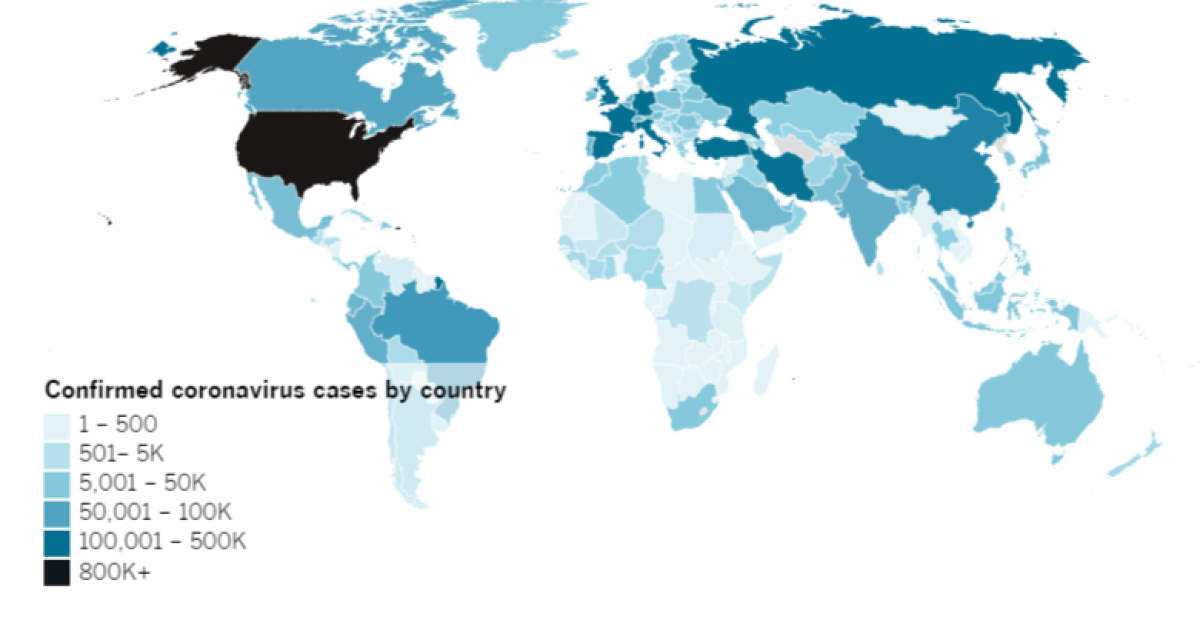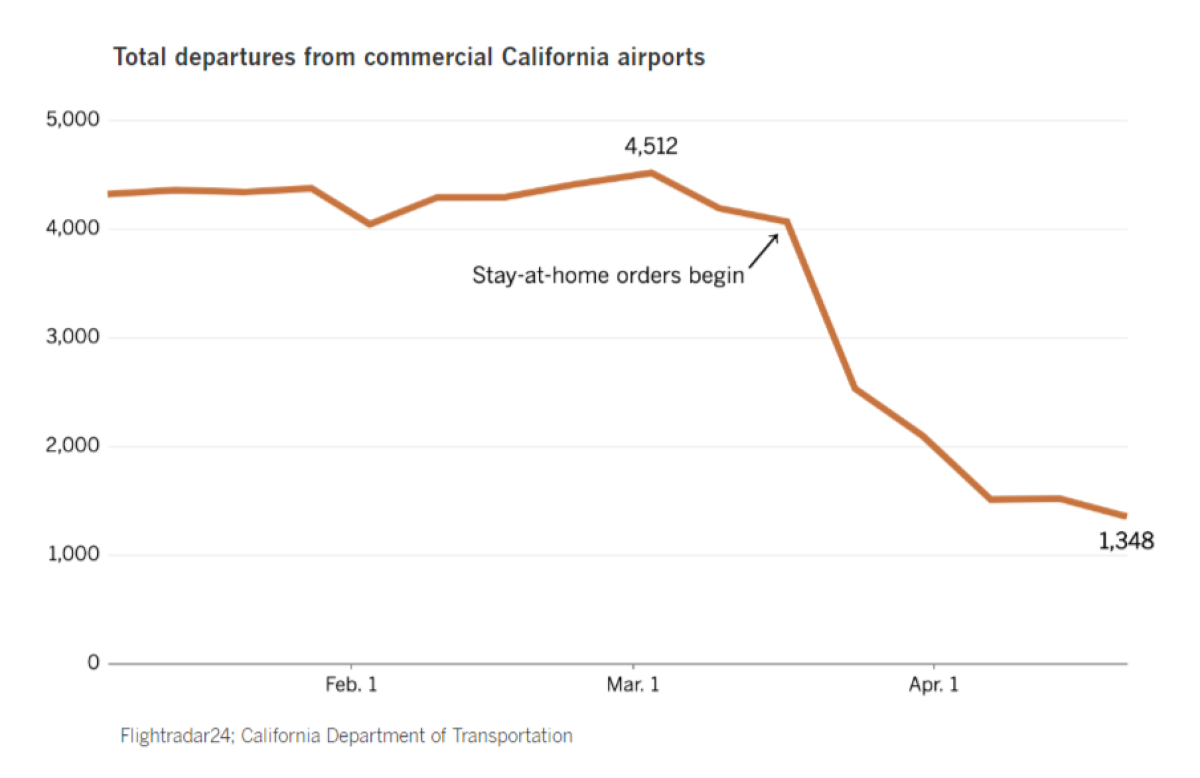Coronavirus Today: The four phases of reopening
Good evening. I’m Diya Chacko, and it’s Tuesday, April 28. Here’s what’s happening with the coronavirus outbreak in California and beyond.
Phase one of reopening California: Make work as safe as possible for those on the front lines. Offer an economic safety net for low-wage workers, and encourage the use of face coverings.
That’s where California is now, Gov. Gavin Newsom said Tuesday, as he gave new details of his four-phase plan to ease his shutdown order gradually, while preventing new outbreaks that could force another round of closures.
Phase two will restore some access to public spaces and will let lower-risk businesses reopen, including factories, offices and retail outlets with curbside options. Some schools may be allowed to offer summer school programs or consider an earlier start to the new school year to make up for lost educational opportunities, and more child care facilities will be allowed to reopen.
In phase three, higher-risk workplaces including salons, gyms and theaters will be allowed to reopen with changes and limits on the size of gatherings, and in-person religious services and weddings can proceed. Phase four will effectively lift the shutdown. Concerts and conventions will resume, and fans will be allowed to attend sports events.
There are no timetables for when to move from one phase to the next. Instead, officials will use testing, hospitalization and other benchmarks to decide. But with pressure mounting from some local officials to reopen the state, the proposal also makes clear that state officials, not cities or counties, will decide when to proceed. And Newsom offered no guarantees as to when the plan would move into the second phase.
Newsom’s announcement comes after several governors across the country prepared to begin easing stay-at-home orders, even as the number of U.S. coronavirus cases topped 1 million and the U.S. death toll exceeded that of the Vietnam War. More than 1,000 people have now died in L.A. County, and some local officials still worry that reopening too soon could cause new outbreaks and hurt the economy more in the long run. But daunting as the numbers are, L.A. County, home to 10 million people, is nowhere near as bad off as New York City.
Hollywood is already mapping out a return to what was until recently a new golden age of movie production. Shoots may return sooner in countries such as Iceland where the virus hasn’t hit as hard, and others including Sweden and Denmark that have had less restrictive shutdowns. Once film and TV production resumes more broadly, it could come with smaller crews, tightly controlled sets and minimal travel. The stakes are high for the major studios, including Walt Disney and Warner Bros., which need more content to feed their new streaming platforms.
For now, though, the Academy of Motion Picture Arts and Sciences has changed the eligibility rules for next year’s Academy Awards, which have long required films be screened in at least one theater in Los Angeles for a week to be eligible. With cinemas shut down, films now for the first time in Oscars history will be able to qualify for consideration without a theatrical release.
By the numbers
California cases and deaths as of 6 p.m. PDT Tuesday:
Track the latest numbers and how they break down in California with our graphics.
Where is the coronavirus spreading?

Your support helps us deliver the news that matters most.
Across California
The virus’ impact has been widespread in the Coachella Valley, a retirement hot spot that’s home to some of the state’s densest concentrations of seniors — the people most at risk from COVID-19. “Our demographics were working against us to a certain extent,” a Rancho Mirage doctor said, adding that the first patients there “were the country club set that traveled, got together and showed up COVID-positive. Then very quickly thereafter, it became a community-wide disease.” But an early and aggressive response from Riverside County public health officials and most residents adhering to social distancing orders have helped stabilize the rate of new cases.
Children generally aren’t as susceptible to serious COVID-19 complications as the elderly, but for vulnerable patients in children’s hospitals, there’s still a risk. At Children’s Hospital Los Angeles, the cafeteria temporarily closed, the dog therapy program has moved online, one floor has been repurposed to isolate patients who are at high risk for the virus, and workers have been trying to ease kids into tougher new health and safety protocols. At Children’s Hospital Orange County, patients are offered virtual magic shows and ukulele lessons, and families are offered tele-health platforms.
One Silicon Valley startup, Curative-Korva, now performs most of the public testing across L.A. County to diagnose active COVID-19 cases. Its rapid growth is owed in part to a self-administered oral test that’s less invasive than a nasal swab — but it’s not the method preferred by the Food and Drug Administration. If the approach works, it could usher in a much more streamlined form of testing, but if it turns out to be less accurate, it could muddy the measurements tracking the scope of the outbreak.
Asymptomatic essential workers, including delivery, ride-hail and taxi drivers, as well as grocery store employees and journalists, will now be able to be tested for the virus, L.A. Mayor Eric Garcetti said Monday. Many workers are concerned about their safety, and some say their employers are not providing protective equipment or enforcing social distancing. “I’m so scared for my babies,” said a deli manager in Sun Valley, one of 10 essential workers who told us what their lives are like now. “I’m praying that I don’t have it.”
In March, Los Angeles enjoyed three straight weeks of good air quality, the longest stretch in at least four decades, according to federal Environmental Protection Agency data. But has the drop in traffic eliminated the smog? Not exactly, experts say: Much of the improvement was also due to stormy spring weather, which has given way to a heat wave. But the situation does offer an unintended glimpse of what the nation’s smoggiest region could be like if more of its cars were electric, scientists and regulators say.
How to stay safe
— Wash your hands for at least 20 seconds! Here’s a super-fun how-to video.
— Stop touching your face, and keep your phone clean.
— Watch for symptoms including fever, cough and shortness of breath. The CDC recently added six more: chills, repeated shaking with chills, muscle pain, headache, sore throat and new loss of taste or smell. If you’re worried you might be infected, call your doctor or urgent care clinic before going.
— Practice social distancing, maintaining a six-foot radius of personal space in public.
— Wear a mask if you leave home for essential activities. Here’s how to do it right.
— Here’s how to care for someone with COVID-19, from monitoring their symptoms to preventing the virus’ spread.
How to stay sane
— Was your job affected by the coronavirus? Here’s how to file for unemployment.
— Here are all the ways to stay virtually connected with your friends.
— Visit our free games and puzzles page for daily crosswords, card games, arcade games and more.
— Here are some free resources for restaurant workers and entertainment industry professionals having trouble making ends meet.
— Advice for helping kids navigate pandemic life includes being honest about uncertainties, acknowledging their feelings and sticking to a routine. Here’s guidance from the CDC.
Around the nation and the world
About 70% of America’s freight travels by truck, and many of its 3.5 million truck drivers are busier than ever, keeping shelves stocked with medical supplies and groceries. But the outbreak has left others idle and brought new concerns about health and security on the road. Unlike the airlines, the trucking industry didn’t get a federal stimulus bailout. Thousands of truckers are jobless, and others have reported lower pay and more dangerous working conditions during the pandemic.
Air travel has continued to fall dramatically during the pandemic, with flights from major airports across the globe being reduced each week. Since early March, the number of departures has fallen just over 60%, according to a Times analysis of millions of aircraft radar records. The figures reflect “the most steep and potentially sustained decline in air travel history,” said the president of L.A.’s Board of Airport Commissioners. “Clearly, the magnitude of what we are facing is immense.”

For those still flying, some airlines are taking steps to increase onboard safety. American Airlines is now urging passengers to wear masks, while JetBlue is requiring them. “This is the new flying etiquette,” its chief operating officer said. The changes come days after a flight attendants union asked Transportation Secretary Elaine Chao and Health and Human Services Secretary Alex Azar to mandate masks for employees and passengers. Chao suggested she would leave it up to the airlines.
And once the tourism sector is allowed to reopen, the pandemic might upend hotel and hospitality traditions such as daily room cleaning, face-time with front desk agents and the ubiquitous breakfast buffet. Instead, expect less furniture and more hand sanitizer dispensers, social distancing signs and masked staffers.
Your questions answered
Today’s question comes from readers who want to know: Does cooking food kill the coronavirus? Cooking editor Genevieve Ko asked an infectious diseases expert.
There have been no cases of COVID-19 associated with ingestion of food. Like many other viruses, bacteria and parasites, if the coronavirus is swallowed and carried into the digestive system, it will most likely be destroyed by stomach acids. Should it survive into the intestine, there is no pathway which will carry it to the lungs, and therefore no chance for the disease to attack the respiratory system.
Scientists found that a close relative to the coronavirus dies at temperatures of 56 to 65 degrees Celsius, or 132.8 to 149 degrees Fahrenheit. Most cooked food gets at least that hot while it’s being prepared.
Aside from cooking, routine safety practices, like keeping your kitchen clean and thoroughly rinsing produce, should be enough to keep your food virus-free.
Got a question? Our reporters covering the coronavirus outbreak want to hear from you. Email us your questions, and we’ll do our best to answer them. You can find more answers in our Frequently Asked Questions roundup, and in our morning briefing.
For the most up-to-date coronavirus coverage from The Times, visit our live updates page, visit our Health section and follow us on Twitter and on Instagram.





